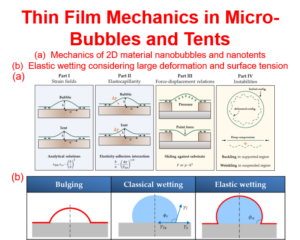
Flexible and stretchable electronics make use of all kinds of thin films including metallic, ceramic, polymeric membranes and even atomically thin solids called 2D materials. Poking and bulging are widely used setups for characterizing the mechanical and interfacial properties of thin films. We call the poked and bulged thin solids to be tents and bubbles (a-b), respectively. Although classical elasticity solutions are available for macroscale poking and bulging problems, the boundary condition has been largely limited to clamped edges and the electrocapillary effects are too trivial to be considered. At microscale, however, the behaviors of the bubbles and tents are governed by the interplay of nonlinear elasticity, surface and interface effects, as well as instabilities. As a result, my group has carried out a series of in-depth mechanics modeling works along with a few experimental validations to have successfully answered the following important questions: 1) How do surface and interface energies dictate the geometry of the bubbles?1,2 2) How does the edge slippage modify the mechanical responses of the tents and the bubbles?3 3) How do the radial buckle delaminations form and what are their indications?4 4) How would those effects modify the load-deflection or the p–V curves?2,5 These fundamental understandings have led to a few significant impacts: 1) They provide guidance for the deterministic formation of micro-bubbles and tents. 2) They offer a direct solution to the pressure, force, and strain in micro-bubbles and tents simply out of their geometry. 3) They allow reliable extraction of the elastic and interfacial properties of 2D materials and ultrathin polymeric membranes which are otherwise difficult to handle and measure. We have also published three well-received invited review papers on 2D material mechanics.6,7,8
1 Sanchez, D.A., Dai, Z., Wang, P., Cantu-Chavez, A., Brennan, C.J., Huang, R., and Lu, N.: ‘Mechanics of spontaneously formed nanoblisters trapped by transferred 2D crystals’, Proceedings of the National Academy of Sciences, 2018, 115, (31), pp. 7884-7889
2 Rao, Y., Qiao, S., Dai, Z., and Lu, N.: ‘Elastic Wetting: Substrate-Supported Droplets Confined by Ultrathin Elastic Membranes’, J Mech Phys Solids, 2021, 151, pp. 104399
3 Dai, Z., Hou, Y., Sanchez, D.A., Wang, G., Brennan, C.J., Zhang, Z., Liu, L., and Lu, N.: ‘Interface-Governed Deformation of Nanobubbles and Nanotents Formed by Two-Dimensional Materials’, Physics Review Letters, 2018, 121, (26), pp. 266101
4 Dai, Z., Sanchez, D.A., Brennan, C.J., and Lu, N.: ‘Radial Buckle Delamination around 2D Material Tents’, J Mech Phys Solids, 2020, 137, pp. 103843
5 Dai, Z., and Lu, N.: ‘Poking and bulging of suspended thin sheets: Slippage, instabilities, and metrology’, J Mech Phys Solids, 2021, 149, pp. 104320
6 Akinwande, D., Brennan, C.J., Bunch, J.S., Egberts, P., Felts, J.R., Gao, H., Huang, R., Kim, J.-S., Li, T., Li, Y., Liechti, K.M., Lu, N., Park, H.S., Reed, E.J., Wang, P., Yakobson, B.I., Zhang, T., Zhang, Y.-W., Zhou, Y., and Zhu, Y.: ‘A review on mechanics and mechanical properties of 2D materials—Graphene and beyond’, Extreme Mechanics Letters, 2017, 13, pp. 42-77
7 Dai, Z., Lu, N., Liechti, K.M., and Huang, R.: ‘Mechanics at the interfaces of 2D materials: Challenges and opportunities’, Current Opinion in Solid State and Materials Science, 2020, 24, (4), pp. 100837
8 Sanchez, D.A., Dai, Z., and Lu, N.: ‘2D Material Bubbles: Fabrication, Characterization, and Applications’, Trends in Chemistry, 2021, 3, (3), pp. 204-217






